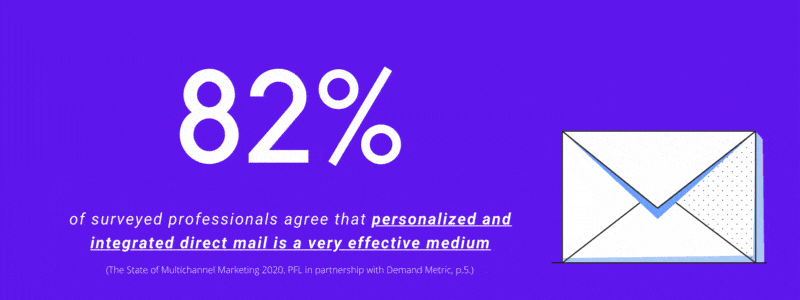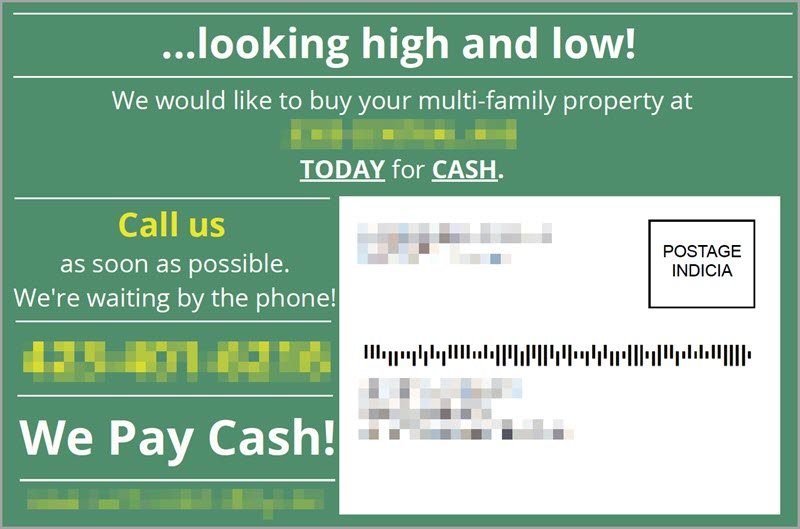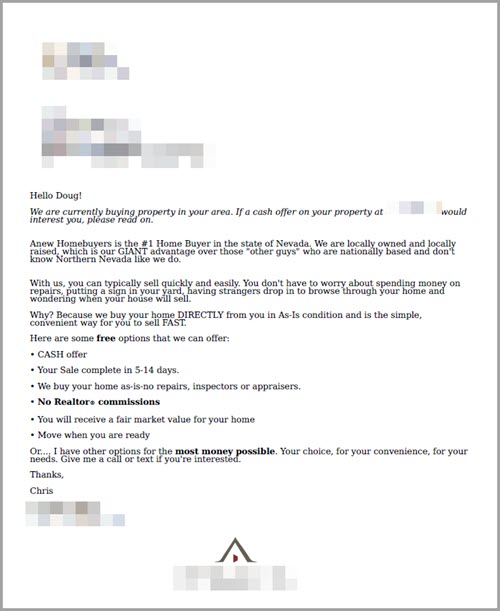
We’ve seen a big increase recently in the number of successful, highly automated direct mail real estate investing campaigns developed in Postalytics. It is clear that the targeting, mass personalization and workflow advantages of direct mail automation help these campaigns deliver great leads.
When we analyze the campaigns, we see that real estate investment marketers are leveraging several common techniques to find motivated sellers. Successfully finding qualified prospects depends on several factors:
- Clearly stated objectives
- Target audience identification
- Value proposition
- Clear call to action
- Follow-up
- Repetition and consistency
Finding the investment properties that match your profile and then convincing the owners to sell is a challenge. Fortunately, real estate investors have many tools they can use to improve their marketing performance and create favorable outcomes. Unfortunately, some tools can be confusing or intimidating, and investors shy away from them.
Direct mail is a real estate investment marketing tool that can seem expensive and complicated, but it doesn’t have to be. Technology advances in direct mail make it easy and affordable to add direct mail to a real estate investor’s lead-building strategy. When they use direct mail intelligently and take advantage of current technology, this channel can produce responses more efficiently than other direct marketing methods.
The Direct Marketing Association (now the ANA) measured the direct mail response rate for purchased mailing lists to be at least five times greater than marketers can expect with email, paid search, online display, or social media.

Still, real estate investors are hesitant to invest in direct mail campaigns. They perceive the process as complicated and time-consuming. That was true a decade ago, but things have changed.
Marketers, including real estate investors, no longer need to learn about postal rules, endure long lead times, and be confused by postal and printing vernacular. Investors can now pay for direct mail as they use it, time their contacts perfectly, and leave the details up to the experts. We designed Postalytics specifically for marketers who had attempted and then abandoned direct mail or never tried it at all because of the expense and the challenges of setting up and managing the process.
What Are The Most Important Success Factors For Direct Mail Real Estate Investing?
Let’s examine those factors we mentioned above and dive deeper into what they mean and how they affect the success of direct mail campaigns for real estate investors.
Clearly Stated Objectives
Before you embark on a project to design direct mail campaigns, you must be clear about what you want to accomplish. Most times, the objectives will be associated with lead development, but not always. Brand awareness is another common goal that investors can achieve via direct mail. The mailpieces included in a brand awareness campaign will differ from the postcards, letters, or other materials you produce to attract prospects.
Target Audience Identification
You may market to multiple audiences, and your messages to each group will differ. Are you looking for commercial or residential properties? Do you specialize in condominiums or single-family homes? What are your geographical limits? Do you prefer dealing with low value properties or high-priced real estate? You cannot market effectively until you understand the characteristics of the audience you wish to influence.
Value Proposition
Why would someone do business with you? What benefit will they enjoy by selling you their property? What makes you different from your competition? Answer questions like these and you can communicate a value proposition to prospects in your direct mail campaigns.
Clear Call to Action
What do you want prospects to do when they receive your direct mail piece? Call you? Visit a website to read customer testimonials? Fill out a form that helps you qualify them and their property? Watch a video that explains your value proposition more thoroughly? Except for giving prospects multiple ways to contact you, we recommend your mailpieces include a single, obvious call to action.
Follow-up
This piece is critical. Be sure your follow-up plan is in place before beginning your direct mail campaign so you can act quickly and effectively when someone responds to your direct mail. Your follow-up steps might be a personal email or phone call, or it could be an additional piece of content that provides more information about your services. If you connect your CRM system to Postalytics, direct mail fulfillment of follow-up material may be automatic.
Repetition and Consistency
A single mailpiece won’t get you many leads. Experts tell us it can take seven or more “touches” before a prospect will respond. If you specialize in buying properties from individuals motivated by a time limit, such as an impending foreclosure, you might close deals with fewer touches. However, it pays to design a series of contacts as part of your lead development strategy. With the help of your CRM system you can automatically “drip” direct mail, email, text, or phone messages to your prospects over time. The drip sequence can be turned off or switched to a new sequence once a prospect advances past the initial interest stage. Postalytics customers can access the US Postal Service tracking data. The tracking information allows marketers to send reinforcing digital messages timed to coincide with the direct mail delivery dates.
For an explanation of how direct mail tracking works, see:
Isn’t Direct Mail Expensive For Great Direct Mail Real Estate Investing Campaigns?
Direct mail costs more than digital channels like email or social. This keeps some people from considering postal mail for lead acquisition. They’ve received quotes from local print service providers, faced minimum order quantities, and lack the budget for casting the wide net they believe is necessary to succeed with direct mail.
One reason Postalytics makes sense for investors just beginning a direct mail program is that our customers pay only for the mail they produce. Our services feature no minimum mailpiece amount and no upfront investments in postcards, stationery, envelopes, or postage. Real estate investors can start small and advance to lower per-piece price tiers as their mail volumes grow and become more predictable.
Another reason direct mail seems expensive is the shotgun approach that used to be prevalent in the direct mail business. Direct mail isn’t really done that way anymore. Unless it matches their business strategy, no marketers should mail to every household in a zip code, for example. With readily available data sources and filtering, real estate investors can lower costs by purging untargeted individuals from their mailing lists and concentrating on their best prospects.
How Do I Find Motivated Sellers For My Direct Mail Real Estate Investing Campaigns?

To get the greatest benefit from a direct mail campaign, start with a list of people most eager to sell their property. If you’re looking for residential property to buy, sending “I want to buy your house” postcards and letters to random homeowners in a targeted neighborhood isn’t likely to result in a large number of leads. You will waste a good portion of your campaign budget soliciting business from people with roots in an area and unlikely to move. They have jobs and friends in the area. Their children are in school, and they attend the church down the street.
However, certain groups of people will be more motivated to sell their homes. If you approach these people at the right time, with the right campaigns, your success ratio will be much higher than the random technique and your investment in direct mail will yield greater results. Here are some campaign ideas for finding motivated sellers:
Expired Listings Campaigns
You might ask “what value does tracking and following up on expired listings provide”? The answer is that with an automated system, expired listing campaigns can generate tremendous return without a lot of ongoing work.
An expired listing postcard campaign is a powerful and easy to execute opportunity for real estate investors. The homeowners wanted to sell their home but were unsuccessful. You’ll need access to the Multiple Listing Service (MLS) to find out about expired listings. A well-timed direct mail piece sent to sellers whose listings have expired can prompt them to consider another solution. If time-related events like relocating for work, financial issues, divorce, or changes in health drove the original decision to list the home, a quick sale to an investor may be an attractive option.
Potential or Pre Foreclosure Marketing
Approaching homeowners behind on mortgage payments and facing foreclosure is another way to target motivated sellers. In most cases, selling their property to an investor is a better outcome that going through foreclosure. Title companies may compile pre-foreclosure lists but be sure to research the properties as these lists can be out of date. Marketing to owners already in the foreclosure process may be fruitless, so timing is important. You must develop a method to send single pre foreclosure marketing postcards or letters to take advantage of this window of opportunity.
Distant Landlords
Tax authority websites can provide property owner information. Look for owners who live out of state. These individuals may wish to discontinue dealing with maintenance or tenants at a distance. These people have less of an emotional attachment to the property than resident homeowners and may be more willing to consider an investor’s offer to buy their rental property. Some third-party list brokers may also rent out-of-state landlord lists to real estate investors.
Probate
Relatives that inherit homes often sell quickly to settle the estate and distribute the sale proceeds among the heirs. Probate records are public information, but generally require manual work to compile a list. Investors must examine records filed in the courts to find potential sellers. Because building a list of inherited properties is more difficult, fewer investors pursue this lucrative source of leads. A well-designed direct mail piece that arrives at the right time won’t be competing with communications from other investors.
Most of these methods rely on contacting prospective sellers at the right time. Something that happened in their lives makes them ideal leads. This event should trigger a personalized letter or postcard from you, the real estate investor, offering a solution to their problem.
For more information, see this article about the value of triggered direct mail:
What Type Of Mail Should You Send To Ensure Direct Mail Real Estate Investing Success?
Most real estate investors use postcards, letters, or both. Your campaigns may include postcards of different sizes and designs, and letters of one to six double-sided pages. Regardless of the mailpiece format, the mail must grab the prospect’s attention and make an interesting offer that is relevant to the recipient.
Personalized mailpieces always improve response rates. With tools like Postalytics, real estate investors can easily include known details about the property or the potential sellers in their postcards and letters. The Postalytics system allows for variable data, variable images, and variable logic.
Interactivity is another aspect of direct mail that is often overlooked. A Quick Response (QR) code or a Personalized URL (pURL) in a postcard or letter allows prospects to transition from the physical environment of direct mail into the digital world. Here you can deliver videos, slide shows, worksheets, and other personalized content to engage with potential customers.
This article is all about Personalized URLs: https://www.postalytics.com/blog/how-to-use-personalized-urls-to-measure-direct-mail-response/
How frequently you mail depends on your audience. Some cases, such as impending foreclosure, provide a relatively brief window of opportunity and you’ll need to mail more often. In other, less urgent, circumstances you can spread your mailings over a longer time. Experiment to see what works best for you but be sure to design campaigns to include multiple mailings. A single touch is unlikely to produce the results you desire.
Real Estate Investor Postcards


Although postcards can be as small as 4” x 6” most Postalytics customers choose the larger sizes: 6” x 9” or 6” x 11” because they stand out among the other mail delivered to customer mailboxes. Although the larger size postcards provide plenty of room for marketing copy, do not fill the space with text. Postcards should convey a single, compelling message. Too many details on a postcard, even the jumbo size ones, is usually a mistake.
Certain areas of a postcard are reserved for the mailing address, postal barcode, and mailing permit indicia. If you are handling your direct mail campaign on your own, your mailing service provider should show you where you can and cannot include text and graphics. Marketers can also look up the specifications in the USPS documentation. The Postalytics template editor automatically blocks restricted areas so designs cannot infringe upon the protected portions of the address side of postcard. You’ll never have to worry about having your mail rejected by the US Postal Service.
The front side of a postcard is for getting attention. The job of the front of a postcard is to get the recipient to turn it over. Use eye-catching photos and graphics to pique curiosity or mention the offer using bold, contrasting colors. Photos of people are attention-grabbers, and with variable images, you can alter the featured people to match demographic information like the age and race of each postcard recipient.
Hire a design professional to create your postcards or use one of Postalytics’ professionally designed templates. Amateur direct mail delivers the wrong message about your company and can limit the effectiveness of your campaign.
This article walks you through simple postcard design using the Postalytics template editor:
Real Estate Investment Personalized Marketing Letters

Letters are opportunities to communicate the benefits of your offer and distinguish yourself from the competition. Unlike postcards, which must be brief and single-focused, letters can be effective at telling a story, communicating details, or covering multiple aspects of your services. Often, letters are triggered by customer actions, such as responding to a postcard by visiting a website or watching a video. When your CRM software is connected to an automated direct mail solution like Postalytics, you can generate personalized letters automatically.
Though letters offer plenty of room to convince people to sell you their property and the copy is a vital component of marketing letters, the text isn’t what convinces most customers to act. The offer is what drives most of the responses you’ll get from direct mail letters. The written copy won’t matter much if you haven’t presented a compelling and relevant offer to the property owners.
Break Up Long Blocks Of Text
Long pages of plain text won’t get read. Use headlines, sub-headings, bullets, call-out quotes, and other methods to break up lengthy text and make your direct mail letters easy to scan. A potential customer should be able to grasp the key points of your communication by skimming the headings and other text and graphical representations in your letter. We recommend judicious use of white space, so letters don’t appear crowded and overwhelming.
Be frugal about fonts. Most marketing letters use four fonts or less. Too many fonts make it difficult for readers to distinguish important passages from the rest of the text. Some marketing experts claim that handwriting fonts improve performance. While that might have been true several years ago, consumers have been exposed to handwriting fonts for quite a while now. Nobody is fooled into thinking someone took the time to hand-write a personal letter.
Letters are good places to show off your expertise. Use some of the space to include helpful information and present testimonials from former customers. Express empathy for homeowners who may be going through tough times, forcing them to consider selling their home. Tapping into emotions is effective but avoid going for shock value. Exaggerated claims or false statements of urgency fall flat and can turn off prospects before you ever have a chance to cultivate their business.
Unlike postcards which can only hint at a set of comprehensive set of services, your letters can present a complete solution. Use the space in letters to walk prospects through the complete process of selling you their home, explaining the benefits of each step along the way. Present your most important points in the areas of letters that get the most attention from readers: the main headline, first paragraph, last paragraph, and postscript.
Careful editing is probably more important than writing the draft for a direct mail letter. Have an experienced individual read your copy and make editing suggestions. Make sure grammar and spelling are error free, use active verbs, and remove extra words that make your message harder to read and understand.
Here’s a Postalytics article about writing effective direct mail letters:
Direct Mail Real Estate Investing Campaigns Can Work For You
If you’re a real estate investor, you should be including direct mail in your marketing mix. You’re dealing with properties with known addresses and owners, so you can perfectly aim mailpieces at each property. A wealth of demographic information about the property and owners makes it easy to compose highly personalized communications. With modern techniques, investors can fine-tune their mailing lists and spend money on only their most likely prospects. Automation and triggered communications enable real estate investors to include direct mail as part of their overall marketing strategies.
About the Author

Dennis Kelly
Dennis Kelly is CEO and co-founder of Postalytics, the leading direct mail automation platform for marketers to build, deploy and manage direct mail marketing campaigns. Postalytics is Dennis’ 6th startup. He has been involved in starting and growing early-stage technology ventures for over 30 years and has held senior management roles at a diverse set of large technology firms including Computer Associates, Palm Inc. and Achieve Healthcare Information Systems.
